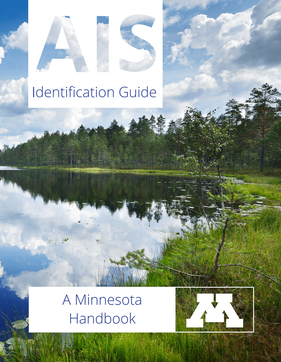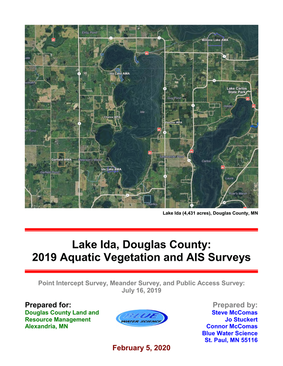Aquatic Invasive Species
ILA works diligently to prevent the spread of Aquatic Invasive Species (AIS) in Lake Ida. To that end, we have two District Directors who have received training on identifying AIS to help property owners identify AIS issues in Lake Ida. We have a three-member standing committee that develops an annual CLP treatment plan and budget that is approved by the ILA board at the September meeting. ILA has been treating Lake Ida to reduce the spread of Curly Leaf Pondweed (CLP) in the lake. In addition, we contract for additional hours of boat inspections at the public landings on the lake to help reduce the spread of AIS from lake to lake and to help educate boat owners on proper procedures for transporting their boats.
Curly Leaf Pondweed (CLP)
ILA has been actively pursuing solutions to reduce the Curly Leaf Pondweed (CLP) invasive species in Lake Ida over the past several years. The results of the first 2009 evaluation are below. After studying the issue for several years, three large areas along the western shorelines of Lake Ida were first treated in the Spring of 2018. The ILA Officers contracted for another survey of the whole lake, including the sites that were treated, which was completed in June 2018 (see below). Each year since, ILA has contracted for a survey of the lake, followed by treatment to reduce the spread of CLP. It appears that this approach has significantly reduced the spread and is slowly beating CLP back.
ILA continued the Curlyleaf Pondweed (CLP) management program in 2022. Following an annual delineation survey, the DNR approves a specific treatment plan based on the survey. Then PLM Lake Services implements the treatment. Grants obtained from Douglas County Land and Resources reimburses ILA for 75% of the estimated treatment cost. ILA also applied for and received a Minnesota Department of Natural Resources grant for $2,850 that counts toward the County grant's 25% matching funds requirement. The total cost of treatment in 2022 was $22,278 ($2,190 for the survey and $20,088 for treatment). By effectively applying for grants and leveraging the available funds, ILA paid the balance of $6,916 for the 2022 CLP management program.
Treatment for CLP must be done when the water temperatures are between 55 and 65 degrees and before the other native aquatic plants emerge. This generally means that treatments are done in May, either before or after Memorial Day. Some of the surveyed areas showing CLP are not able to be treated because of water depth and thermocline restrictions (the chemicals do not work beyond that depth).
The 2021 CLP treatment was completed on June 6, 2022 and covered 13.8 acres. While the ideal goal would be to eradicate CLP, the size and depth of Lake Ida makes it impossible to fully rid the lake of CLP. ILA hopes to keep the CLP contained to deep water areas where it does not reach the surface to impede the water activities that our residents love.
ILA continued the Curlyleaf Pondweed (CLP) management program in 2022. Following an annual delineation survey, the DNR approves a specific treatment plan based on the survey. Then PLM Lake Services implements the treatment. Grants obtained from Douglas County Land and Resources reimburses ILA for 75% of the estimated treatment cost. ILA also applied for and received a Minnesota Department of Natural Resources grant for $2,850 that counts toward the County grant's 25% matching funds requirement. The total cost of treatment in 2022 was $22,278 ($2,190 for the survey and $20,088 for treatment). By effectively applying for grants and leveraging the available funds, ILA paid the balance of $6,916 for the 2022 CLP management program.
Treatment for CLP must be done when the water temperatures are between 55 and 65 degrees and before the other native aquatic plants emerge. This generally means that treatments are done in May, either before or after Memorial Day. Some of the surveyed areas showing CLP are not able to be treated because of water depth and thermocline restrictions (the chemicals do not work beyond that depth).
The 2021 CLP treatment was completed on June 6, 2022 and covered 13.8 acres. While the ideal goal would be to eradicate CLP, the size and depth of Lake Ida makes it impossible to fully rid the lake of CLP. ILA hopes to keep the CLP contained to deep water areas where it does not reach the surface to impede the water activities that our residents love.
June 2009 Lake Ida CLP Evaluation
June 2018 Lake Ida CLP Delineation Report
May 2018 Lake Ida CLP Treatment Tracks
May 2019 Lake Ida CLP Delineation Report
May 2019 Lake Ida CLP Treatment Tracks
May 2020 Lake Ida CLP Delineation Report
May 2020 Lake Ida CLP Treatment Tracks
May 2021 Lake Ida CLP Delineation Report
May 2021 Lake Ida CLP Treatment Tracks
May 2022 Lake Ida CLP Delineation Report
May 2022 Lake Ida CLP Treatment Tracks
2022 Delineation, Treatment, and Post-Treatment Meander Survey Maps
June 2018 Lake Ida CLP Delineation Report
May 2018 Lake Ida CLP Treatment Tracks
May 2019 Lake Ida CLP Delineation Report
May 2019 Lake Ida CLP Treatment Tracks
May 2020 Lake Ida CLP Delineation Report
May 2020 Lake Ida CLP Treatment Tracks
May 2021 Lake Ida CLP Delineation Report
May 2021 Lake Ida CLP Treatment Tracks
May 2022 Lake Ida CLP Delineation Report
May 2022 Lake Ida CLP Treatment Tracks
2022 Delineation, Treatment, and Post-Treatment Meander Survey Maps
Curly Leaf Pondweed Presentation to MAISRC
The University of Minnesota Aquatic Invasive Species Research Center (MAISRC) holds a monthly ZOOM meeting, Detector Connector, allowing AIS Detectors to share ideas and questions as a group. Often, MAISRC brings in an outside expert to talk on a specific topic. Bob Reed and David Geddes, our Lake Ida AIS Detectors, participate in most meetings.
On December 3, 2021, David Geddes presented a case study on Curlyleaf Pondweed Management in Lake Ida (click title for presentation). He spoke for about 20 minutes, followed by abut 40 minutes of discussion, questions, and answers about what different lake associations are doing, their challenges, and their successes.
On December 3, 2021, David Geddes presented a case study on Curlyleaf Pondweed Management in Lake Ida (click title for presentation). He spoke for about 20 minutes, followed by abut 40 minutes of discussion, questions, and answers about what different lake associations are doing, their challenges, and their successes.
Other Valuable AIS Information
Minnesota Aquatic Invasive Species (AIS) Research Center
https://www.maisrc.umn.edu
MAISRC is a comprehensive center for research and information about aquatic Invasive Species in Minnesota. The site contains information about the Starry Trek statewide survey day for AIS.
https://www.maisrc.umn.edu
MAISRC is a comprehensive center for research and information about aquatic Invasive Species in Minnesota. The site contains information about the Starry Trek statewide survey day for AIS.

AIS Identification Guide
This ID book contains tips for identifying a number of aquatic invasive species (AIS) that are considered
high-risk to Minnesota waters, as well as some common native lookalike species.
As you look at identifying characteristics and descriptions in the pages that follow, bear in mind that colors and sizes can be variable. These are general guidelines, not definitive taxonomic identification characteristics. Whenever possible, key or unusual characteristics about a species are highlighted, but specimens can often look very similar. They may also sometimes be found outside of the suggested habitats.
If you are in doubt as to whether you have found an AIS, you may first want to contact one of the ILA AIS Representatives for help. They may submit a report to the DNR using EDDMapS or the Great Lakes Early Detection Network (GLEDN) app, or may contact a DNR AIS Specialist if they need more information.
You will notice two different styles of maps in this book: for native species, watershed maps are used to highlight where species are generally found. Again, this can vary — these maps are a guideline. For invasive species, county maps are used to provide more localized distribution information. Maps are current using available data as of February 2018. For more information on this book and AIS research, please visit www.maisrc.umn.edu.
This ID book contains tips for identifying a number of aquatic invasive species (AIS) that are considered
high-risk to Minnesota waters, as well as some common native lookalike species.
As you look at identifying characteristics and descriptions in the pages that follow, bear in mind that colors and sizes can be variable. These are general guidelines, not definitive taxonomic identification characteristics. Whenever possible, key or unusual characteristics about a species are highlighted, but specimens can often look very similar. They may also sometimes be found outside of the suggested habitats.
If you are in doubt as to whether you have found an AIS, you may first want to contact one of the ILA AIS Representatives for help. They may submit a report to the DNR using EDDMapS or the Great Lakes Early Detection Network (GLEDN) app, or may contact a DNR AIS Specialist if they need more information.
You will notice two different styles of maps in this book: for native species, watershed maps are used to highlight where species are generally found. Again, this can vary — these maps are a guideline. For invasive species, county maps are used to provide more localized distribution information. Maps are current using available data as of February 2018. For more information on this book and AIS research, please visit www.maisrc.umn.edu.

Lake Ida 2019 Aquatic Vegetation and AIS Surveys
On July 16, 2019, a summer point intercept survey was combined with a meander survey and a public access survey on the 4,431 acre Lake Ida, Douglas County. Plant growth was found to a depth of 21 feet and aquatic plants were estimated to cover 2,068 acres or 47% of Lake Ida.
The most common submerged aquatic plant was chara. Chara was observed at 120 sites (54% of the sites out to 21 feet deep). The aquatic plant community in 2019 had 22 species of submerged aquatic plants. This is a good plant diversity condition for a lake in this North Central Hardwood Forest ecoregion setting. The number of individual plant species observed at sample points ranged from 1 to 7 with an average of 2.5 species/point (Figure S1).
Zebra mussels which were first observed in 2013, were found attached to aquatic plants at 153 survey sites. Zebra mussel distribution in Lake Ida was estimated at 1,490 acres (34% of the lake area)(Figure S1).
No starry stonewort or other unknown AIS were found in the nearshore meander survey or in the intensive meander survey conducted at public access. Curlyleaf pondweed, an aquatic invasive plant species, was found at 15 sample sites.
On July 16, 2019, a summer point intercept survey was combined with a meander survey and a public access survey on the 4,431 acre Lake Ida, Douglas County. Plant growth was found to a depth of 21 feet and aquatic plants were estimated to cover 2,068 acres or 47% of Lake Ida.
The most common submerged aquatic plant was chara. Chara was observed at 120 sites (54% of the sites out to 21 feet deep). The aquatic plant community in 2019 had 22 species of submerged aquatic plants. This is a good plant diversity condition for a lake in this North Central Hardwood Forest ecoregion setting. The number of individual plant species observed at sample points ranged from 1 to 7 with an average of 2.5 species/point (Figure S1).
Zebra mussels which were first observed in 2013, were found attached to aquatic plants at 153 survey sites. Zebra mussel distribution in Lake Ida was estimated at 1,490 acres (34% of the lake area)(Figure S1).
No starry stonewort or other unknown AIS were found in the nearshore meander survey or in the intensive meander survey conducted at public access. Curlyleaf pondweed, an aquatic invasive plant species, was found at 15 sample sites.